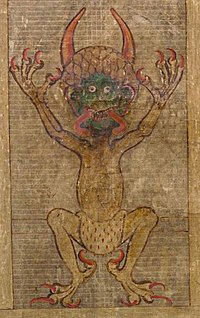


Appearance
Appearance
The codex is contained in a wooden folder, covered with leather and ornamented with metal. At 92 cm (36.2in.) tall, 50 cm (19.7in.) wide and 22 cm (8.6in.) thick it is the largest known medieval manuscript[2]. It initially contained 320 vellum sheets, though eight of these were subsequently removed[3]. It is unknown who removed the pages or for what purpose but it seems likely that they contained the monastic rules of the Benedictines. The codex weighs nearly 75 kg (165 lbs.) and the vellum is composed of calf skin (or donkey according to some sources) from 160 animals.History
The codex was created in the Benedictine monastery of Podlažice near Chrudim, which was destroyed during the 15th century. Records in the codex end in the year 1229. The codex was later pledged to the Cistercians Sedlec monastery and then bought by the Benedictine monastery in Břevnov. From 1477-1593 it was kept in the library of a monastery in Broumov until it was taken to Prague in 1594 to form a part of the collections of Rudolf II.
Swedish plunder
At the end of the Thirty Years' War in the year 1648, the entire collection was stolen by the Swedish army as plunder. From 1649 to 2007 the manuscript was kept in the Swedish Royal Library in Stockholm. The site of its creation is marked by a maquette in the town museum of Chrast.
Return to Prague
On September 24, 2007, after 359 years, Codex Gigas returned to Prague on loan from Sweden until January 2008 (on display previously at the Czech National Library).
Content
The Codex includes the entire Latin Vulgate version of the Bible, except for the books of Acts and Revelation, which are from a pre-Vulgate version. Also included are Isidore of Seville's encyclopedia Etymologiae, Josephus' Antiquities of the Jews, Cosmas of Prague's Chronicle of Bohemia, various tractates (from history, etymology and physiology), a calendar with necrologium, a list of brothers in Podlažice monastery, magic formulae and other local records. The entire document is written in Latin.
The manuscript includes illuminations in red, blue, yellow, green and gold. Capital letters are elaborately illuminated, frequently across the entire page. The codex has a unified look as the nature of
the writing is unchanged throughout, showing no signs of age, disease or mood on the part of the scribe. This may have led to the belief that the whole book was written in a very short time (see Legend). But scientists are starting to believe and research the theory that it took over 20 years to complete.
Page 290, otherwise empty, includes a unique picture of the devil, about 50 cm tall. Several pages before this are written on a blackening vellumLegend
According to legend the scribe was a monk who broke his monastic vows and was sentenced to be walled up alive. In order to forbear this harsh penalty he promised to create in one single night a book to glorify the monastery forever, including all human knowledge. Near midnight he became sure that he could not complete this task alone, so he made a special prayer, not adressed for god but for the fallen archangel "satan" asking him to help him finish the book in exchange for his soul, so the monk sold his soul to the devil. The devil completed the manuscript and the monk added the devil's picture out of gratitude for his aid.[1][7]
Despite this legend the codex was not forbidden by the Inquisition and was studied by many scholars.





